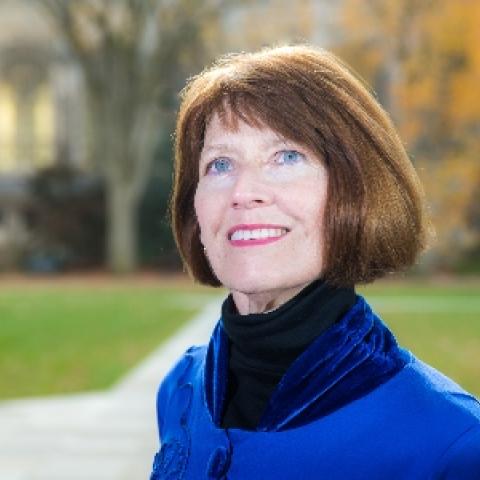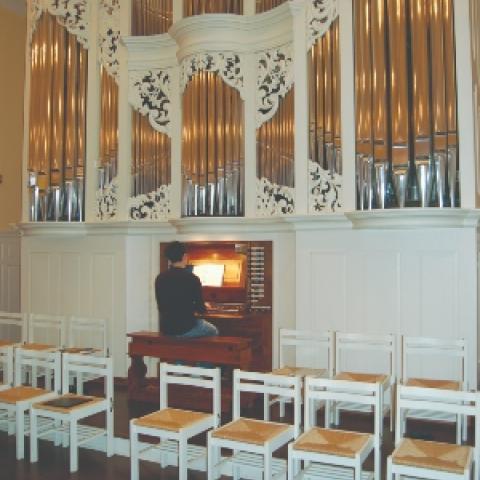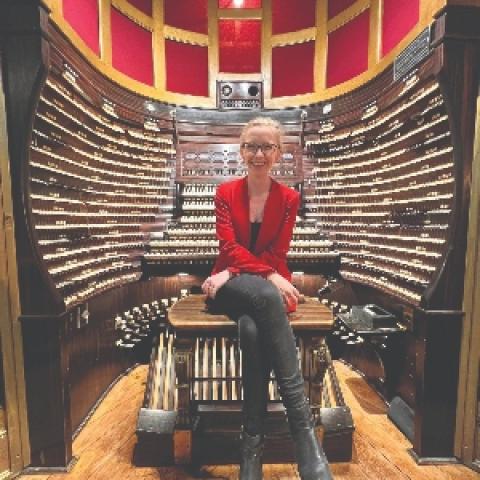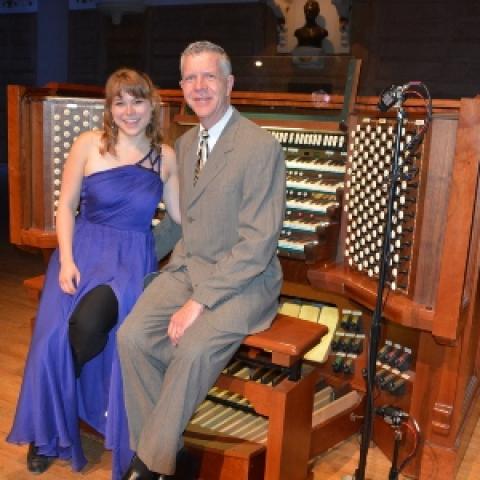Joyce Johnson Robinson is a past editor of The Diapason.

Greg Zelek, named one of The Diapason’s 20 under 30 Class of 2016 (see The Diapason, May 2016, page 31), was the first organist to be awarded Juilliard’s Kovner Fellowship (a merit-based scholarship award that covers the full estimated cost of study at The Juilliard School). Zelek received bachelor’s and master’s degrees and an Artist Diploma from Juilliard, studying with Paul Jacobs. Since September 2017, Zelek has been in Madison, Wisconsin, serving as the Madison Symphony Orchestra’s principal organist and the Elaine and Nicholas Mischler Curator of the Overture Concert Organ, a three-manual, seventy-two-rank Klais instrument that is entirely movable in one large chamber. Prior to holding this position, Zelek has served as organist and music director at several churches in Florida and New York, and spent summers in Spain. He has logged numerous performances with symphonies in Florida, New Jersey, New York, and Wisconsin, and has presented recitals throughout the United States.
Zelek is certainly reaching the career aspirations mentioned in his 20 under 30 essay: “to broaden the audience for the organ, popularizing an instrument that is often misunderstood even by other classical musicians” and to present it “in atypical performances and collaborating with other artists.” He has made significant strides toward these goals, notwithstanding the challenges posed by a virus pandemic in 2020 and 2021. We talked with Greg Zelek to find out the details.
Describe in brief what your position with the Madison Symphony Orchestra entails.
I am the principal organist of the Madison Symphony Orchestra (MSO) and hold the endowed position of the Elaine and Nicholas Mischler Curator of the Overture Concert Organ. I perform with the symphony whenever there is an organ part in a symphonic work and have also been the soloist for organ concertos. As the curator of the Overture Concert Organ, I perform in and plan our organ series (as well as a summer concert series) by selecting and hiring guest artists, organize events for the Friends of the Overture Concert Organ (FOCO), who help support all organ programming, and handle scheduling of organ maintenance. I succeeded Sam Hutchison, who retired in 2017, and am forever grateful to him for the organ program in Madison that he helped shape.
What special things have you done in your position that were new?
As I always do at my live performances, I try to make the event an all-around experience that not only showcases the instrument and repertoire, but also entertains the audience with personal interaction throughout the concert. I began forming relationships with many music aficionados in Madison, and this has allowed for growth of the program and greater enthusiasm for the organ and our performances.
At the annual Free Community Carol Sing, a December holiday event for which you played, the attendance reached a new level in 2019. It had never previously been necessary to open the top levels of the theater to accommodate the crowd. What’s the secret to your success?
The Carol Sing is an incredible tradition that attracts around 1,500 people from all ages to sing Christmas carols accompanied by the organ. I really appreciate everyone in our audience, and I think this mutual admiration from both those in attendance and the performer makes concerts and events much more memorable and entertaining for everyone.
I always open and close the Carol Sing with solo organ works that demonstrate the full scope of our instrument, and I think it’s a great opportunity to share repertoire with children and their parents who otherwise might have never heard the organ before. When everyone in the family can leave with a smile on their face after a concert, you know they’ll be returning (and bringing some family friends).
When the Covid pandemic struck in March of 2020, how did things change for you?
It was difficult to see what exactly we would be doing at the start of the 2020–2021 season, since so much was up in the air immediately following the start of the pandemic. One advantage of playing the pipe organ is that you can perform an entire program without anyone else on stage (which was essential with the social-distancing guidelines in place). I planned two virtual concerts in the fall with the hope that this might give our audience members something to look forward to since there was nothing going on at the start of the new season.
As soon as we began advertising our two virtual streams (I performed the first, and my former organ teacher at Juilliard, Paul Jacobs, performed the second), we had over 1,600 households register and watch the events. While these virtual events are not an equal substitute for our live concerts, they provided the advantage of being able to share music from Overture Hall with a wider community beyond just Madison.
I planned one final virtual event in the spring to close the season with my friend and trumpet player, Ansel Norris, who I had the opportunity to perform with in Naples, Florida, back in March 2020. That Naples performance turned out to be my last live concert before the pandemic, and it seemed appropriate to close our virtual season alongside Ansel, who coincidentally is originally from Madison. It was wonderful to see the majority of the households that registered for these three concerts return to their seats for live concerts at Overture Hall for the 2021–2022 organ season.
What else did you do during the 2020–2021 Covid year?
Apart from the Madison Symphony Virtual Organ Series events, I performed alongside the Madison Symphony’s Maestro, John DeMain, in a virtual Christmas concert that showcased the Klais’s versatility for both solo and accompanied works that was viewed by over 6,000 households. I also had the opportunity to perform at some other venues throughout the pandemic.
I performed my first live concert in over a year with the Jacksonville Symphony Orchestra in a concert for organ and brass ensemble in January 2021. This was my fourth year performing in the event, and it was surreal to play in front of a socially distanced but live audience after so many months away. I also recorded a virtual concert from Longwood Gardens with my friend and fellow Juilliard alum, cellist Thomas Mesa. I then returned to perform Rheinberger’s Second Organ Concerto with the Jacksonville Symphony before another live audience at the end of March 2021.
Things have now opened up. What items are added to your calendar?
We have a very exciting upcoming 2022–2023 organ season at Overture Hall, with performances by guest artists, as well as myself. The Jacksonville Symphony has also invited me back to again be the artist-in-residence for their organ program that is in its second year that showcases their Bryan Concert Organ (a Casavant instrument in Jacoby Hall). Many of the canceled events from the start of the pandemic for which I was booked were rescheduled for both this past 2021–2022 season and this upcoming Fall.
Let’s return to your student years. You grew up in Miami and began piano lessons at age seven. How were you attracted to the organ?
I attended Epiphany Catholic School in Miami, Florida, where they built an entirely new church structure around a magnificent Ruffatti instrument during my time as a student there. Tom Schuster was hired to be the organist, and I began taking piano lessons with him. I then went on to attend New World School of the Arts High School as a pianist, studying with Ciro Fodere. As I moved into high school, I wanted some cash to be able to take my girlfriend out to dinner and the movies, and Tom had said that I could get a church job that paid if I started studying the organ. When you’re a kid, $5,000 a year seems like a million dollars, so I began taking organ lessons with Tom, and here I am, however many years later, doing it professionally!
And you even had a summer job in Spain.
Each summer, we would visit family for a month in a tiny town called Ramales de la Victoria, which is nestled in the mountains of the north of Spain. I would play the Sunday Mass there, which not only helped me grow in appreciation of the music, but also of a very different culture. It also helped me keep up my Spanish that I grew up speaking as a kid, and that I’m still fluent in today.
Your college and graduate work has all been done at Juilliard. What led you to decide to remain at Juilliard for all of your training?
My former organ teacher, Paul Jacobs, is the reason that I chose Juilliard, and there was no reason to go anywhere else once I was there! Paul’s unique vision of the profession made me believe that I might be able to venture outside of the traditional path for organists and do things a little differently. Through his extensive experience with orchestras around the world and his vigorous dedication to making the organ an integral part of the classical music scene, I was motivated to work intensely, set high standards for musical excellence, and develop my own individual style of concertizing. Paul’s passion and work ethic is a constant inspiration to me, and I feel a responsibility to pass on my own passion with anyone and everyone who attends an organ performance.
Was it difficult to adjust to New York City?
I recall Paul Jacobs not allowing me to talk as much as I wanted to in my first couple of lessons, and so I was forced to play (and thus reveal that I was probably less prepared than I should have been). It quickly became clear that I wasn’t going to be able to talk my way out of lessons, and so I really started working and honing my craft. As soon as I realized what it took to learn and internalize music and started memorizing my music for our weekly organ class performances throughout the semester, New York was a dream environment for an aspiring musician. The level of talent in NYC is so high, and it really inspired me to look beyond my life as a student and try to imagine what might be possible in this challenging but very rewarding profession. I then went on to get my master’s and Artist Diploma from Juilliard as well.
Attendance at Madison’s organ programs has increased greatly during your tenure—tripling. How do you account for that?
There is nothing more contagious than enthusiasm, and I hope that I exude enthusiasm whenever I perform. I hear so many organists talk about how they go about selecting music for their concerts (“always include something your audience wants to hear, but make sure you play something that they need to hear”), and I have a very different take on this idea. I generally perform the music that I want to share and feel the responsibility of convincing the audience that they should want to hear it too.
The more I have gotten to know the audience in Madison, the more I feel that they trust me to play the best music and to bring in the top guest artists. There is constant pressure to perform at the highest level, and this is inspiring to me. I also hope that I’m a fairly relatable person. I tend to talk about how my parents don’t know anything about classical music, how my mom thought that giving me a sip of her Manhattan would help calm me before an organ competition, and how my dad may be asleep halfway through my concert. And these types of stories (all true, by the way) tend to make audiences feel comfortable and more attentive to the beautiful music that I have the privilege of performing.
When I first arrived in 2017, we had 224 FOCO households (Friends of the Overture Concert Organ), and this past pandemic year we had over 550. My last organ concert at Overture Hall this past May 2022 had over 1,400 audience members, and I’m proud that we’ve been able to create excitement around our instrument and program in Madison. The Madison community at large is most appreciative and supportive of the arts, and they have welcomed me with open arms. I have made some extremely close relationships in a short period of time, and this is a testament to how gracious and loving the people of Madison really are.
How’s the Klais?
There is something unique about playing a concert hall instrument, and the immediacy of sound is both electrifying and thrilling. Everyone in Madison is so proud to have a world-class organ in our César Pelli-designed concert hall, especially considering that there are many cities larger in size than Madison, such as New York City, that don’t. The instrument was built by Klais in 2004 and gifted to the MSO by Pleasant T. Rowland (a Madison native and the founder of the American Girl books and brand). With over 4,000 pipes and 63 stops, there are countless sounds to choose from, and it really brings all different styles of music to life.
The MSO website (madisonsymphony.org) mentions “Pop-up Events.” Can you tell us about these?
When I first arrived, the Madison Symphony Orchestra League asked if I would play for a Party of Note, where they sell a certain number of tickets to an event that supports the MSO’s Education and Community Engagement Programs. This event was the first to sell out, and we now do two of them a year. It has been a great opportunity to play for some new organ enthusiasts, and it also gives me the chance to meet and perform for audience members who attend the symphony but have never gone to an organ event.
What sorts of programs have you done with children?
We have had a number of elementary and middle school classes take a field trip to Overture Hall for me to explain the organ and have them sit down and play the instrument themselves. It is wonderful to see the unique personalities of each student shine through the instrument, with some choosing the loudest sounds on the instrument, and others wanting to play on the softer and more delicate stops.
Prior to the pandemic, I had the students select the different organ sounds for a Bach fugue, and then I performed it using the stops they had selected. The children were excited by both the colors that could be drawn from the organ and the physical aspect of playing this instrument. I was also recently featured in the MSO’s LinkUp Program, which is a music education offering created by Carnegie Hall’s Weill Music Institute. It was virtual this year, and they showcased the pipe organ in our hall, which I think is a wonderful way to introduce this incredible instrument to our youth.
You are bilingual. Have you been able to utilize that in your work?
It was my Cuban grandfather on my mother’s side that imparted to me the musical gene. He is the reason that I am a musician today, and he also inspired me to arrange works like Malagueña, by the Cuban composer, Ernesto Lecuona. It’s been wonderful to speak Spanish with supporters at receptions, and my Cuban heritage has given me an insight into a different culture. This has allowed me to relate to a wider variety of people, which has been helpful in making friends for our organ program.
Donors generously contributed $30,740.54 to name the Solo division of the Overture Concert Organ in honor of you for your twenty-eighth birthday. That’s quite an honor!
This was a complete surprise to me, and I was shocked in gratitude when they presented me with this honor at a donor event on the day of my birthday. It was done to commemorate my “golden birthday,” which was something that I had never heard of prior to this moment. (Editor’s note: A golden birthday occurs in the year you turn the same age as your birthday—so, turning twenty-eight on October 28, 2019.)
You’ve done some of your own arrangements. (I particularly enjoyed your Clair de Lune.) Do you arrange with the Klais in mind, or were these written prior to Madison?
That particular arrangement was completed prior to my arrival in Madison. I’m grateful to hear that you enjoyed it, because I think some of these reimagined pieces work really well on our Klais. I have, however, recently commissioned an organ and cello sonata from Daniel Ficarri, a classmate from Juilliard, written for our Klais and to be performed with cellist Thomas Mesa in the 2022–2023 season.
Are there any recordings on the horizon?
I will soon be recording my first organ CD as the MSO’s organist and plan on releasing it at my concert in September 2022. I will be performing the works on the CD at the opening of the 2022–2023 season concert and will have a sort of “CD Release” party for the event.
Do you have any special goals or plans for the future?
I think it is imperative that I constantly think of new ways to keep our program fresh and exciting, and presenting a variety of performers and repertoire is fundamental to keeping an audience engaged. It’s a challenge to retain audience members year after year and continue to attract new ones if the program itself doesn’t evolve over time, and so I am always learning new repertoire to perform and thinking of creative ways to program the organ alongside other musicians. It also helps to always have a new joke or two to share with those who attend . . . .
Thank you very much, Greg!
Greg Zelek’s website: gregzelek.com
MSO website: madisonsymphony.org







